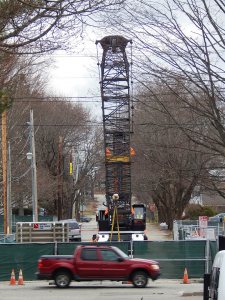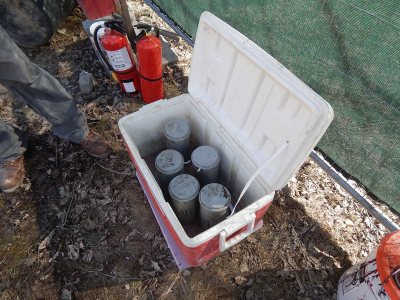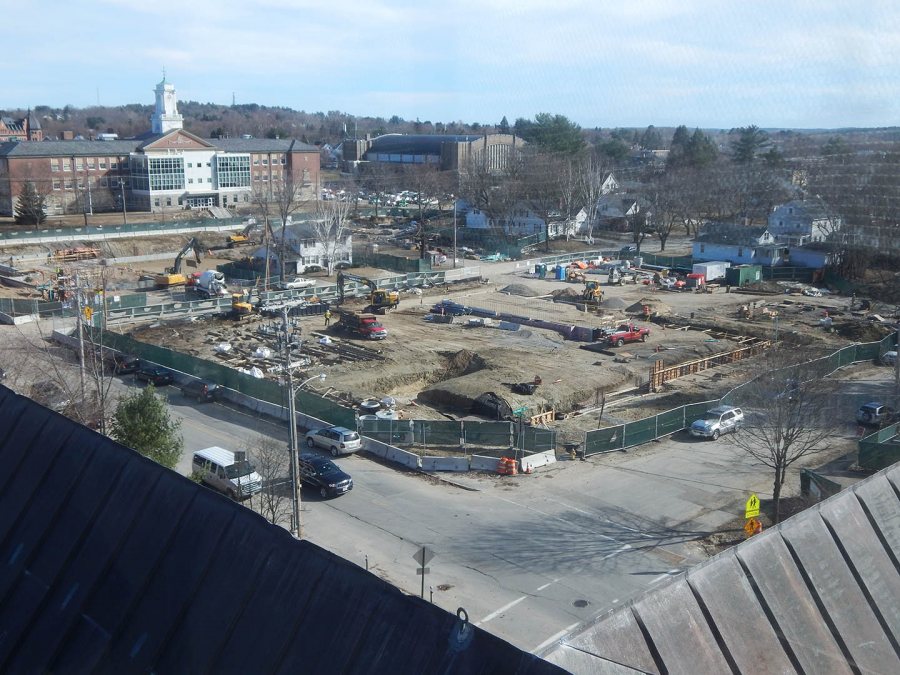
Campus Construction Update: April 21, 2015
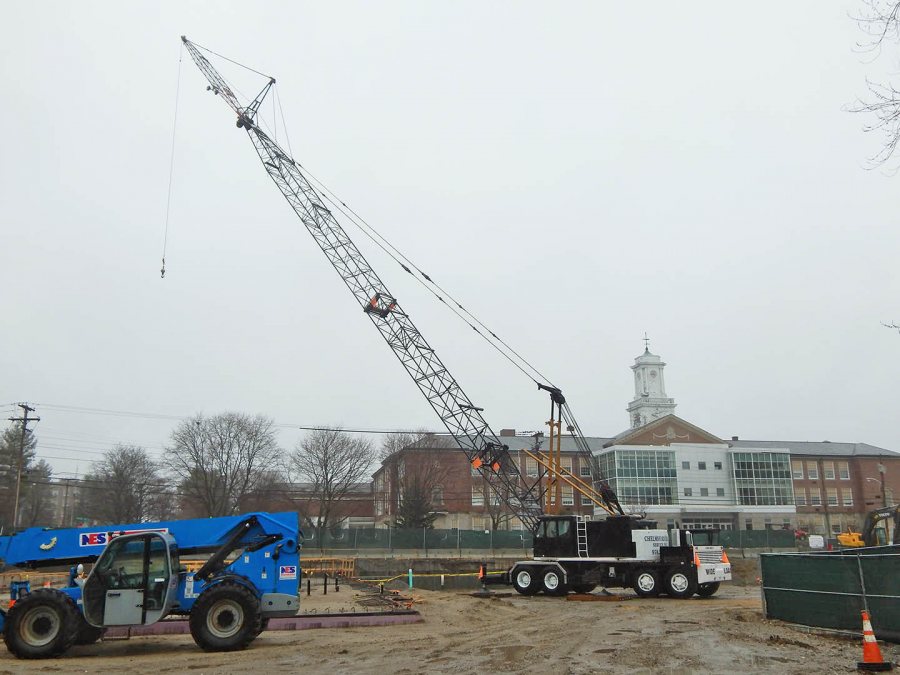
The Link-Bilt crane in place at the 65 Campus Ave. construction site on April 21, 2015, ready to start hoisting into place the steel framework of a new student residence. (Doug Hubley/Bates College)
In regard to the Campus Life Project and Bates’ two new student residences, it’s time to stop thinking about the ground and instead turn our eyes to the sky — at least as high as 55 feet.
With foundation work for the residences on Campus Avenue well past the halfway mark, the construction team is ready to start building the steel skeletons for the two dorms. Workers for Stellar Steel Erectors of West Suffield, Conn., could be hanging steel as early as today.
“That’s a big milestone,” Bates project manager Chris Streifel says. “That will be the first work that people will really be able to see,” because of the fence enclosing the construction sites.
“Things will poke up above the site fence and it’ll start to seem really tangible.”
Stellar Steel arrived last week and got the crane erected April 20, assembling the massive self-propelled Link-Belt at the 55 Campus Ave. construction site and then moving it across Franklin Street to 65 Campus, where the steelwork will begin. There the crane will occupy a pad of soil specially graded and compacted — compacted to 95 percent of possible density — to support the Link-Belt’s weight.
Referring to lead contractor Consigli Construction, Streifel added that this step forward “speaks highly of Consigli’s great work managing the challenges that we faced during the winter,” which included an unexpected need for additional site preparation and the cold, snowy winter itself.
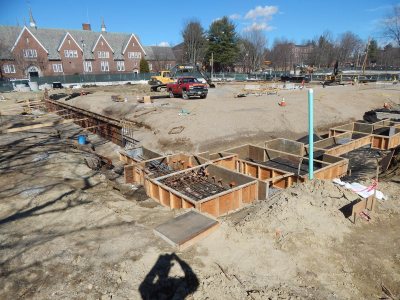
Excavations and forms for footings at 55 Campus Ave., seen on April 14, 2015. (Doug Hubley/Bates College)
You or I might say that we “drove” or “maneuvered” or “skippered” the crane over to 65 Campus (because we would be so likely, and eager, to get that opportunity). But the people who actually deal with big cranes use the verb “walk.” They walked the crane over, because walking speed is plenty fast enough.
Longtime Campus Construction Update readers know that structural steel is typically cut, fitted, marked up and otherwise prepared for assembly before it’s shipped to the work site.
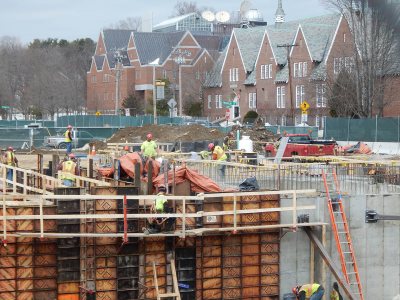
The growing foundation of the student residence at 65 Campus Ave., seen on March 26, 2015. (Doug Hubley/Bates College)
Totaling 635 tons, the structural steel going into the new Bates residences has been fabricated by Norgate Metal of La Guadeloupe, Quebec — a “hard-driving company,” according to the Norgate website.
“There’s some site fabrication, but very little,” Streifel says. “It’s a very engineered system, designed specifically down to the last nut and bolt, and how tight those nuts and bolts need to be and how big the welds are. It’s closely detailed in advance.”
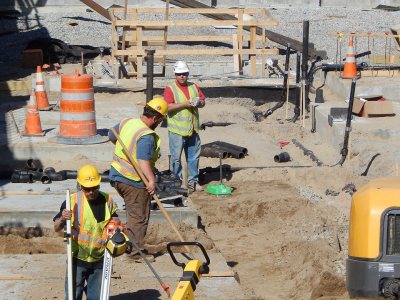
Van Terrell, S.W. Cole Engineering field technician (third from left), prepares to use the green gizmo at his feet to check the soil density in the 65 Campus Ave. cellar hole on April 14, 2015. (Doug Hubley/Bates College)
So the steelwork on site has something in common with using an Erector set, allowing for the obvious differences in scale, risk and importance (not to mention the likelihood that your playmates will monopolize the tools).
When the steel starts swinging, there will be six companies represented on site in all trades, employing 35 to 40 workers.
Meanwhile, foundation work continues. To date, 1,107 cubic yards of concrete have been poured, of a planned total of 1,610, and 130 tons of rebar are embedded within that concrete, out of 170 planned. (Thanks to Consigli staffers Tim Schneider, project manager, and Larry Chouinard, general superintendent, for those figures.)
The foundations at 55 and 65 are quite different. The former, in essence, has a slab on grade (with structural supports going deeper), and the latter, as we have previously pointed out, will have a full basement underlying one wing.
It has been fascinating to watch: first, the excavation and preparation of the site and then, since early March, the creation of a seeming labyrinth or fortress of footings, walls, columns, sumps and pipes. Standing inside the basement of a finished building, you’d never dream of the complex structure that surrounds you.
Virtually all the basement walls at 65 Campus were finished by late last week, but concrete will still be flowing even after steel starts to swing. The last wall to be poured will appear at the southern end of the basement, future site of the loading dock that will serve Office Services and the College Store. That wall must wait until there’s no more need to run heavy equipment into the basement, Consigli’s Tim Schneider explains.
And the floor slab at No. 65 will be poured in early June.
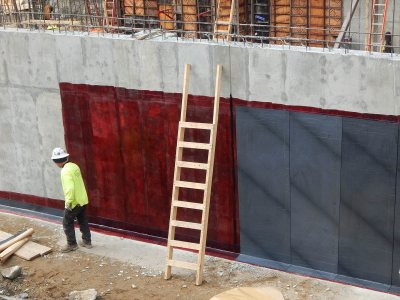
A waterproofing technician steps away from an exterior basement wall at 65 Campus Ave. on March 26, 2015. (Doug Hubley/Bates College)
Gone now are the blankets and heaters that kept the concrete warm enough to cure during the endless winter. Throughout the process, technicians from Maine-based S.W. Cole Engineering have brought samples from each batch of concrete, cylinders about the size of a salami, back to the lab to pressure-test them at regular intervals of time, as they cure. Schneider explains that concrete has to cure to about 75 percent of its designed strength before it can carry steel.
Well, we started in the sky but have somehow ended up back on the cold damp earth. (Ah, life, why must you be so?) Under-slab drainage and ventilation pipes at No. 65 have passed their tests, Schneider notes. He describes one vault-like section of the basement that will house a three-chamber active drainage system, designed to pump storm- and groundwater up to an existing stormwater collector.
We’ll never see it, but we’ll be glad to know it’s there.
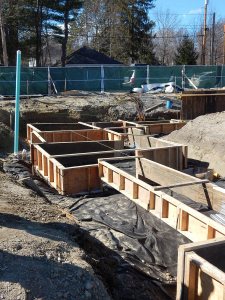
Wooden forms for wall (narrow) and spread (wide) footings at 55 Campus Ave. on April 14, 2015. (Doug Hubley/Bates College)
At 55 Campus, the building footprint is discernible from the foundations now in place. The pace of foundation work is picking up, and by the end of the month we’ll see minor closures of Campus Avenue to make gas and sewer connections. Electrical feeds were brought in last fall, and water hookups will come later.
- For information on current construction activities and planned lane closures, please visit https://www.bates.edu/improvements/campus-avenue-housing/.
Then as the steelwork at 65 Campus wraps up, probably around the beginning of June, there will be a nice episode of contractor choreography as the utilities crews cross over to 65 and Stellar Steel walks the crane back across Franklin Street to 55 Campus.
Can we talk? Campus Construction Update welcomes your questions and comments about current, past and future construction at Bates. Write to dhubley@bates.edu, putting “Campus Construction” or “10 Easy Steps to a More Funnier Sense of Humor!” in the subject line. Or use the 21st-century commenting system below.
